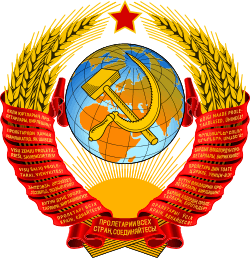Central Executive Committee of the Soviet Union
| Central Executive Committee of the Soviet Union Центральный исполнительный комитет СССР | |
|---|---|
|
| |
.svg.png) | |
| Type | |
| Type | |
| History | |
| Established | 1922 |
| Disbanded | 1938 |
| Preceded by | Various |
| Succeeded by | Supreme Soviet of the Soviet Union |
 |
| This article is part of a series on the politics and government of the Soviet Union |
|
Judiciary |
The Central Executive Committee of the Soviet Union (Russian: Центральный исполнительный комитет, СССР) was the highest governing body in the Soviet Union in the interim of the sessions of the Congress of Soviets of the Soviet Union, existed from 1922 until 1938, when it was replaced by the Supreme Soviet of first convocation.
Structure
Under the 1924 Soviet Constitution, the Central Executive Committee was made up of two chambers: the Soviet of the Union and the Soviet of Nationalities. Beside it there were Central Executive Committees in federal republics, such as the All-Russian Central Executive Committee in RSFSR, Belorussian Central Executive Committee in BSSR, the All-Ukrainian Central Executive Committee in the Ukrainian SSR, and the Central Executive Committee of the Transacaucasian SSR.
Presidium
The Presidium of the Central Executive Committee consisted of 21 members and included the Presidium of the Soviet of the Union and the Soviet of Nationalities. A representative of each constituent republic (initially four) was elected one of the chairmen of the presidium.
- Russian Soviet Federative Socialist Republic: Mikhail Kalinin (December 30, 1922 - January 12, 1938)
- Ukrainian Soviet Socialist Republic: Grigory Petrovsky (December 30, 1922 - January 12, 1938)
- Byelorussian Soviet Socialist Republic: Aleksandr Chervyakov (December 30, 1922 - June 16, 1937)
- Transcaucasian Socialist Federative Soviet Republic:
- Nariman Narimanov (December 30, 1922 - March 19, 1925)
- Gazanfar Musabekov (May 21, 1925 - June 1937)
As more entities (usually previously Autonomous Soviet Socialist Republics) were elevated to the status of constituent republics of the Soviet Union, they received representation among the chairmen of the Presidium:
- Uzbek Soviet Socialist Republic (since 1924): Fayzulla Khodzhayev (May 21, 1925 - June 17, 1937)
- Turkmen Soviet Socialist Republic (since 1925): Nedirbay Aytakov (May 21, 1925 - 21 July 1937)
- Tajik Soviet Socialist Republic (since 1929):
- Nusratullo Maksum (March 18, 1931 - January 4, 1934)
- Abdullo Rakhimbayev (January 4, 1934 - September 1937)
Powers
The 1924 Soviet Constitution defined the powers of the CEC as:
- Calling of the Congresses of Soviets
- Election of the USSR Council of the People's Commissars (Sovnarkom)
- Adoption of decrees and legislative acts.
- Work on legislation and management.